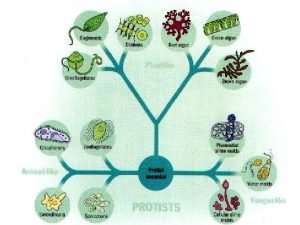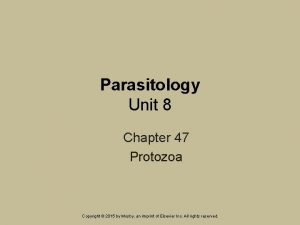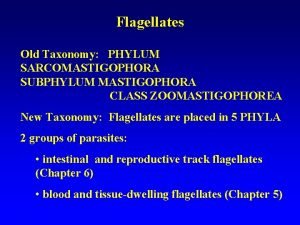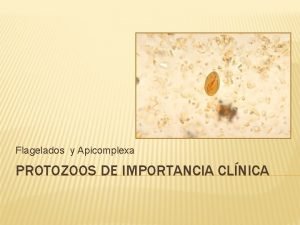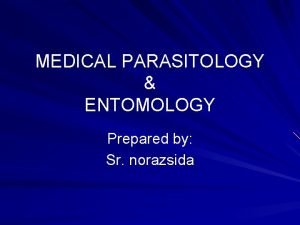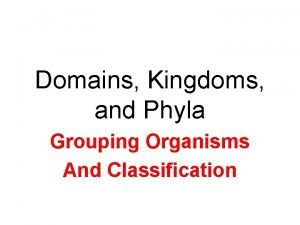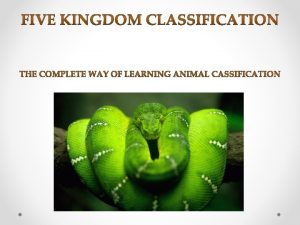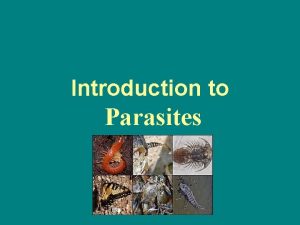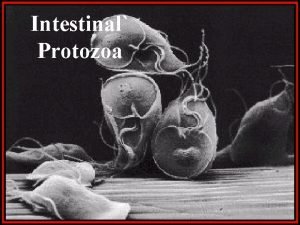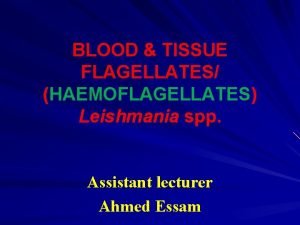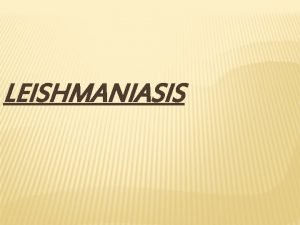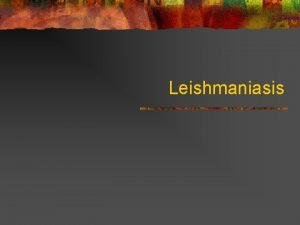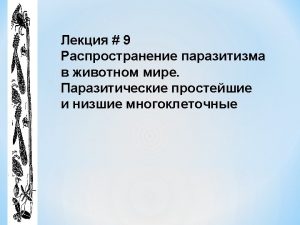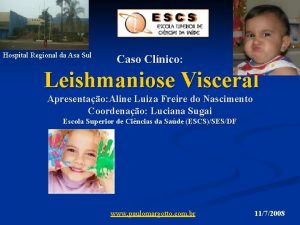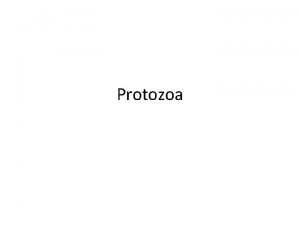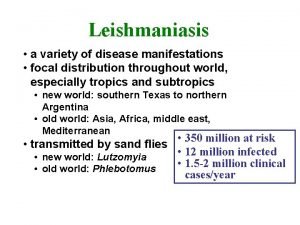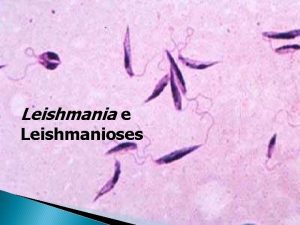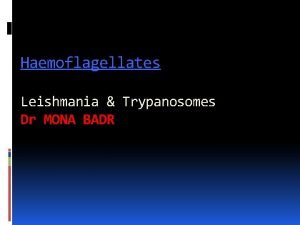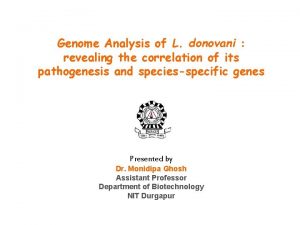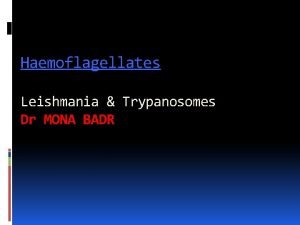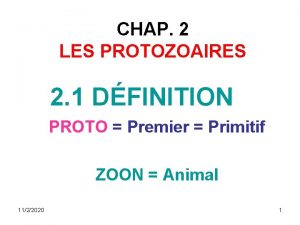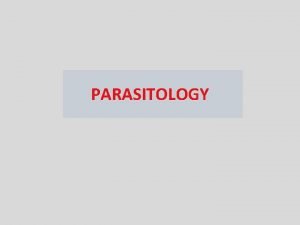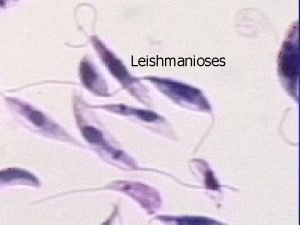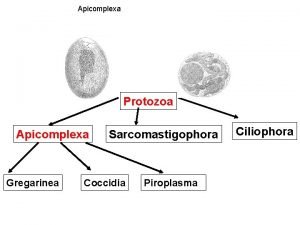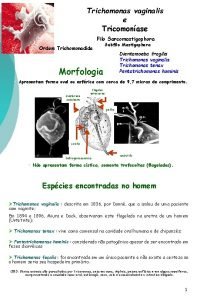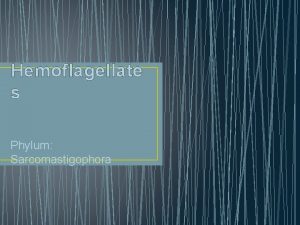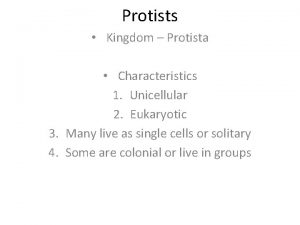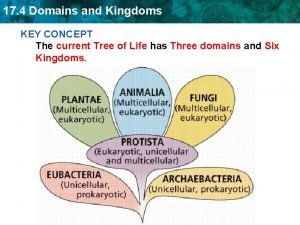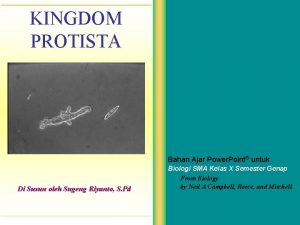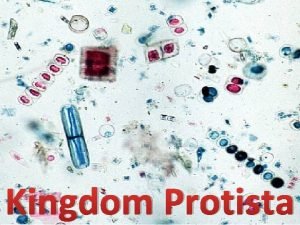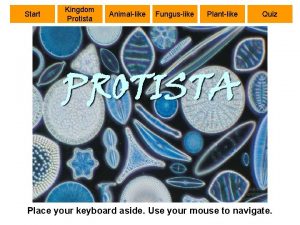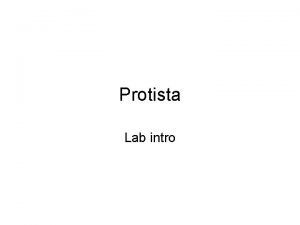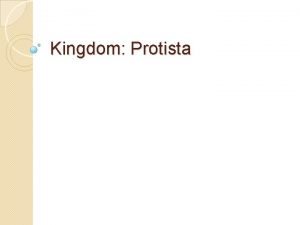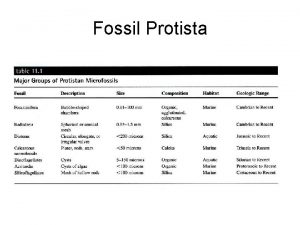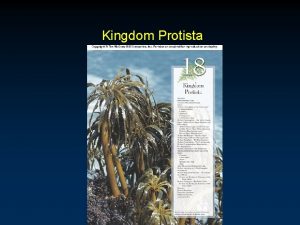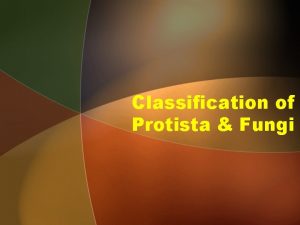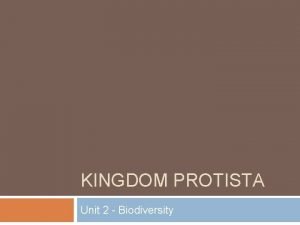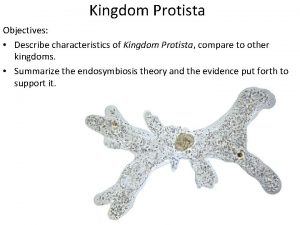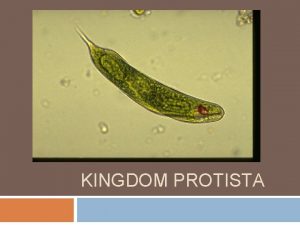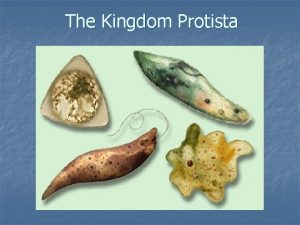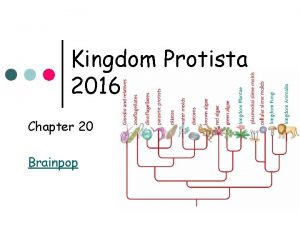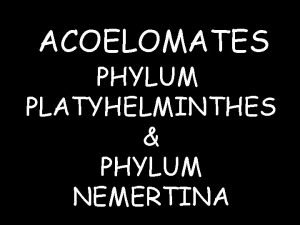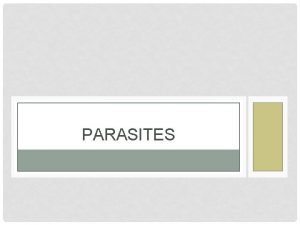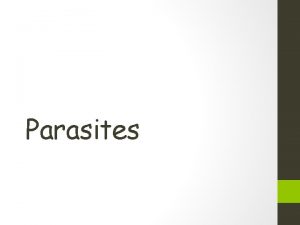Classification of Leishmania parasites Kingdom Protista Phylum Sarcomastigophora
















































- Slides: 48

Classification of Leishmania parasites Kingdom : Protista Phylum : Sarcomastigophora Class : Zoomastigophora Order : Kinetoplastida Family : Trypanosomatidae Genous : Leishmania Subg. : Leishmania Viania (Suprapylarian) (Peripylarian)

Leishmaniaiasis Leishmaniasis is the collective name for a number of diseases caused by protozoan flagellates of genous leishmania , which have diverse clinical manifestations

Causative agent Parasitic protozoa of the genus leishmania , transmitted to human by sandflies. Over 20 species and subspecies infect humans, each causing a different spectrum of symptoms.

Morphology of leishmania parasites *in vertebrate hosts * in sandfly vectors Amastigote Promastigote (Leishman body) (Leptomonad)

Vector of Leishmania Phlebotomus(sandfly ) Larvae of sandfly

Vectors of Cutaneous Leishmaniasis in the world Human are infected via bite of sandflies ( subfamily phlebotominae)-tiny sand-coloured blood-feeding flies that: - breed in dark, damp places, forest area, caves, or the burrows of small rodents -are relatively weak flyers, with a range of only 50 metres from their breeding sites -are most active in the evening and at night - Their numbers are related to natural factors such as rainfull, and may increase with global warming. A ) IN Old World: are phlebotomus sp. ; P. sergenti & P. papatasi(mainly vectors in Iran) and other vectors are P. prrfiliewi, P. caucasicus, P. perniciosus B)In New World: are Lutzomyia sp.

Promastigote (leptomonad) form

Vertebrate hosts

Amastigote form Leishmania organism.

Life cycle of species of Leishmania

Different clinical form of Leishmaniaiasis A) Visceral leishmaniasis B) Cutaneous leishmaniasis C) Muco-cutaneous leishmaniasis

Distribution of Leishmaniaiasis in the world 72 are developing countries -Endemic in 88 countries 13 are among the least developed countries -Population at risk: 350 millions 1 -1. 5 millions cases of C. L -Annual incidence: estimated at 500, 000 cases of V. L. -Overall prevalence: 12 millions people - More than 90% of C. L. cases occur in; Iran, Algeria Afghanistan, , Brazil, Peru, Saudi Arabia and Syria More than 90% of V. L. Cases occur in 5 countries ; Bangladesh, India , Nepal, Sudan, and Brazil 1, 410, 000 male -The DALY burden is 2, 357, 000 946, 000 female -Annual death due to V. L. is 24, 000 female 59, 000 cases 35, 000 male *DALYS-Disability Adjusted Life Years (due to premature death and disability)

Disturbing increase in the number of C. L. cases in several area In Brazil : 1998; 21, 800 cases, 2003; 60, 000 cases In Afghanistan : 1994; 14, 200 cases, 2002; 67, 500 cases In Syria : 1998; 3900 cases, 2002; 6, 275 cases Related factors: - Economic development Behavioural and enviromental changes including : development of new settlements, deforestatio, massive migration from rural to urban area, fast and unplaned urbanization, ………

Geographical distribution



Different clinical form of Cutaneous Leishmaniaiasis Anthroponotic. C. L. (L. tropica) (Dry sore or Urban C. L. ) 1) Old world C. L. Zoonotic C. L. ( L. major) (Wet sore or Rural C. L. ) Diffuse or Disseminated C. L. (L. aethiopica) 2) New world C. L. Cutaneous L. (L. mexicana Complex) ( Chiclero ulcer) Muco-cutaneous L. ( L. braziliensis) ( spoundia or Pian bois or Uta)

Clinical Features of cutaneous leishmaniasis • The factors determining the form of disease include; leishmania species, geographic location, and immune response of the host. • Cutaneous leishmaniasis is characterized by one or more cutaneous lesions on areas where sandflies have fed. • Persons who have cutaneous leishmaniasis have one or more sores on their skin. The sores can change in size and appearance over time. They often end up looking somewhat like a volcano, with a raised edge and central crater. • A scab covers some sores. The sores can be painless or painful. Some people have swollen glands near the sores (for example, in the armpit if the sores are on the arm or hand).

Urban C. leishmaniasis (Dry sore)

Lesions of Z. C. L. ( Wet sore)

Reservior hosts of Z. C. L Rhombomys opimus and other wild rodents as reservior host of Z. C. L.

Different form of C. leishmaniasis

Epidemiology of common form of Leishmaniasis in Iran A) Anthroponotic Cutaneous Leishmaniasis: -It is common in man and endemic cities. -Cuasative agent: L. tropica; smaller than L. major P. sergenti -Transmition ways: 1) man to man by sand fly vector 2)contact infection (inoculable & oinoculable) 3)Mechanical transmitionfrom an open ulcer( by stable fly: Stomoxys) -Reservior host: Mainly; man occasionally dog

Epidemiology of common form of Leishmaniasis in Iran B) Zoonotic Cutaneous Leishmaniasis: - Rural Oriental sore is a zoonosis with human infections occuring only sporadically. - Causative agent : is L. major - Reservior host: the principal reservior host in Iran is : the gerbil Rhobomys opimusm, a grounddwelling rodent. Secondary reservior are Meriones lybicus erythrourus, Tatera indica, Nesokia indica and Meriones hurrianea. - The principal vector in Iran is Phlebotomus papatasi, other vectors are P. caucasicus, P. ansarii, P. m ongolensis

Geographical varieties of visceral leishmaniasis ( Dum fever , Kala-azar ) 1) Indian kala-azar Cuasative agent (L. donovani complex) L. donovani 2) Mediterranean kala-azar L. (d. ) infantum 3) African kala-azar L. (d. ) archibaldy 4) American kala-azar L. (d. ) chagasi

Clinical Features of visceral leishmaniasis Persons who have visceral leishmaniasis usually have fever, weight loss, and an enlarged spleen and liver (usually the spleen is bigger than the liver). Some patients have swollen glands. Certain blood tests are abnormal. For example, patients usually have low blood counts, including a low red blood cell count (anemia), low white blood cell count, and low platelet count. Some patients develop post kala-azar dermal leishmaniasis. Visceral leishmaniasis is becoming an important opportunistic infection in areas where it coexists with HIV.

Clinical Features of visceral leishmaniasis

Epidemiology of Visceral Leishmaniasis in Iran Mediterranean Kala-azar: - Causative agent is L. infantum - Reservior host: involving canine such as Dog, Jackal and other wild carnivorouses. - The probably main vector in Iran is Phlebotomus major, other vectors are P. keshishiani, P. wenyoni, ……. - Age distribution: the disease occure in children from 1 to 4 years of age.

Distribution of Leishmaniaiasis in the Iran - Incidence rate of C. L. is: 0. 28 (thousands) - The most cases related to Isfahan and Bushehr provinces : 1. 66 (thousands) -The least cases related to Mazandaran province : 0. 22 (thousands) -Annually 20, 000 cases of C. L. is repoted from different regions of Iran(1989, Azmoodae)


Laboratory Diagnosis Examination of Giemsa-stained slides of the relevant tissue is still the technique most commonly used to detect the parasite

Diagnostic findings Microscopy • Isolation of the organism in culture (diphasic NNN medium) • Inoculation in experimental animals (hamsters) constitutes another method of parasitilogic confirmation of the diagnosis, and in addition can provide material for further investigations (e. g. , isoenzyme analysis). • Antibody detection can prove useful in visceral leishmaniasis but is of limited value in cutaneous disease, where most patients do not develop a significant antibody response. • Other diagnostic techniques exist that allow parasite detection and/or species identification using biochemical (isoenzymes), immunologic (immunoassays), and molecular (PCR) approaches. Such techniques, however, are not readily available in general diagnostic laboratories.

Microscopy finding A B

Treatment • Physicians may consult CDC to obtain information on how to treat leishmaniasis. The drug sodium stibogluconate is available under an Investigational New Drug protocol from the CDC Drug Service. Also, see recommendations in The Medical Letter (Drugs for Parasitic Infections).

Number cases of Cutaneous Leishmaniasis in Abarkooh city from 1376 to 1383

Number cases of Cutaneous Leishmaniasis in Ardakan city from 1376 to 1383

Number cases of Cutaneous Leishmaniasis in Bafgh city from 1376 to 1383

Number cases of Cutaneous Leishmaniasis in Taft city from 1376 to 1383

Number cases of Cutaneous Leishmaniasis in Khatam city from 1376 to 1383

Number cases of Cutaneous Leishmaniasis in Meyboad city from 1376 to 1383

Number cases of Cutaneous Leishmaniasis in Yazd city from 1376 to 1383

Numbf er cases o Cutaneous Leishmaniasis in Yazd province from 1376 to 1383

f





Life cycle of Leishmania sp.
 Are protists polyphyletic
Are protists polyphyletic Sarcomastigophora are unicellular immotile parasites
Sarcomastigophora are unicellular immotile parasites Luminal protozoa
Luminal protozoa Mastigophora class
Mastigophora class Phylum apicomplexa characteristics
Phylum apicomplexa characteristics Clean pots
Clean pots Baccilariophyta
Baccilariophyta Bilateral symmetry worm
Bilateral symmetry worm Old kingdom middle kingdom new kingdom
Old kingdom middle kingdom new kingdom Nnn ruled
Nnn ruled Old kingdom middle kingdom new kingdom
Old kingdom middle kingdom new kingdom Capital of egypt during the old kingdom
Capital of egypt during the old kingdom Sarcomastigophora classification
Sarcomastigophora classification Examples of archaea kingdom
Examples of archaea kingdom Monera classification
Monera classification Order family genus
Order family genus Parasite introduction
Parasite introduction E histolytica cyst
E histolytica cyst Leishmania tropica
Leishmania tropica Leishmania disease
Leishmania disease Leishmania donovani
Leishmania donovani цилиатура
цилиатура Protozoario leishmania
Protozoario leishmania Diarrhea
Diarrhea Leishmania disease
Leishmania disease Teste de montenegro
Teste de montenegro Leishmania life cycle
Leishmania life cycle Leishmania
Leishmania Parasita
Parasita African trypanosomiasis life cycle
African trypanosomiasis life cycle Protista phylum
Protista phylum Embranchement des sarcomastigophora
Embranchement des sarcomastigophora Characteristics of sarcomastigophora
Characteristics of sarcomastigophora Amastigota
Amastigota Apicomplexa
Apicomplexa Solco trichovac
Solco trichovac Sarcomastigophora habitat
Sarcomastigophora habitat Protista ex
Protista ex Euglenoids unicellular multicellular
Euglenoids unicellular multicellular Protista kingdom
Protista kingdom 4 kingdoms of life
4 kingdoms of life Monera, protista, fungi, plantae animalia
Monera, protista, fungi, plantae animalia Ppt protista kelas 10
Ppt protista kelas 10 Kingdom fungi domain
Kingdom fungi domain Characteristics of protista
Characteristics of protista Quiz 2 animal-like protists
Quiz 2 animal-like protists Protists
Protists Kingdom protista multicellular unicellular
Kingdom protista multicellular unicellular Kingdom protista habitat
Kingdom protista habitat
